JEEP WRANGLER 2007 JK / 3.G Owners Manual
Manufacturer: JEEP, Model Year: 2007, Model line: WRANGLER, Model: JEEP WRANGLER 2007 JK / 3.GPages: 467, PDF Size: 8.83 MB
Page 271 of 467
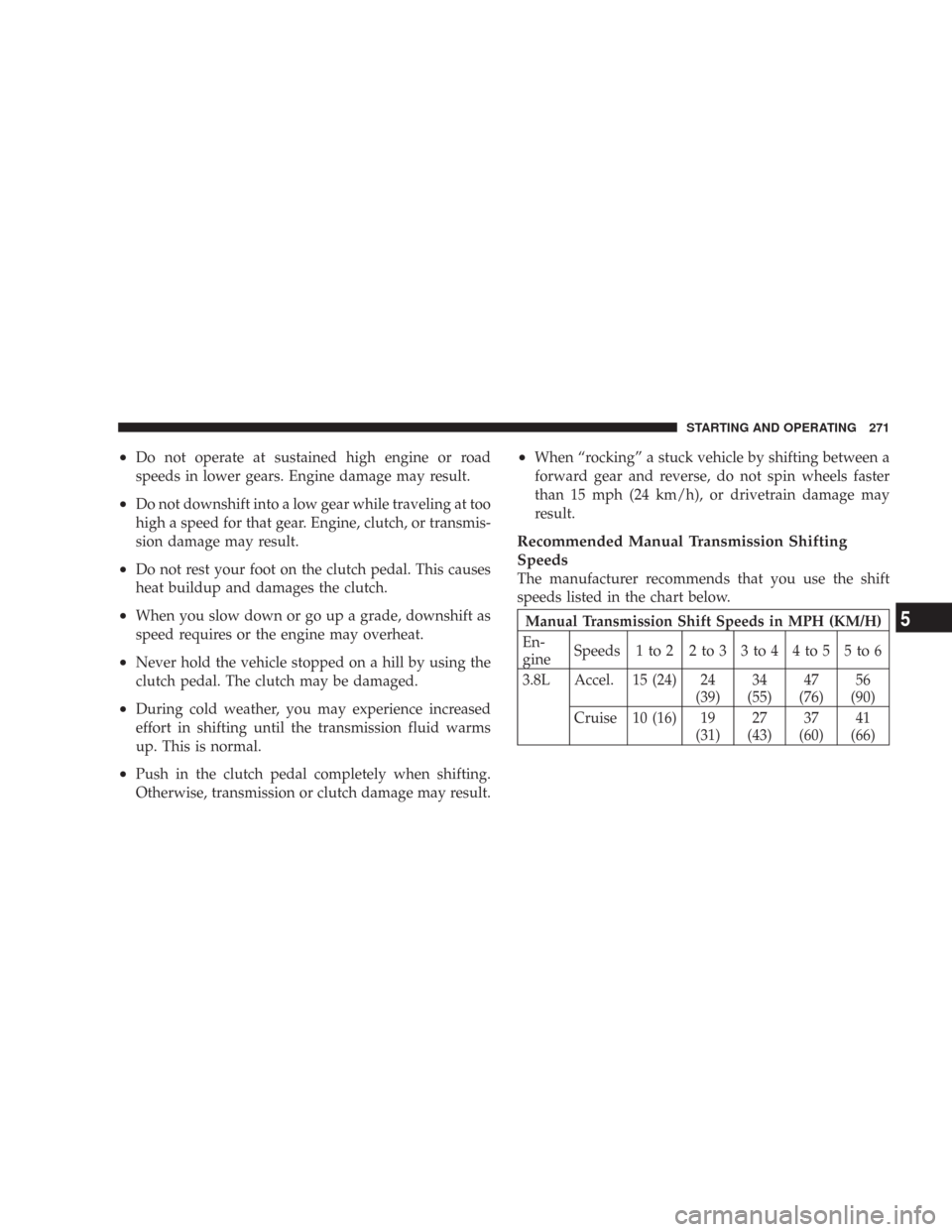
•Do not operate at sustained high engine or road
speeds in lower gears. Engine damage may result.
•Do not downshift into a low gear while traveling at too
high a speed for that gear. Engine, clutch, or transmis-
sion damage may result.
•Do not rest your foot on the clutch pedal. This causes
heat buildup and damages the clutch.
•When you slow down or go up a grade, downshift as
speed requires or the engine may overheat.
•Never hold the vehicle stopped on a hill by using the
clutch pedal. The clutch may be damaged.
•During cold weather, you may experience increased
effort in shifting until the transmission fluid warms
up. This is normal.
•Push in the clutch pedal completely when shifting.
Otherwise, transmission or clutch damage may result.
•When “rocking” a stuck vehicle by shifting between a
forward gear and reverse, do not spin wheels faster
than 15 mph (24 km/h), or drivetrain damage may
result.
Recommended Manual Transmission Shifting
Speeds
The manufacturer recommends that you use the shift
speeds listed in the chart below.
Manual Transmission Shift Speeds in MPH (KM/H)
En-
gineSpeeds 1 to 2 2 to 3 3 to 4 4 to 5 5 to 6
3.8L Accel. 15 (24) 24
(39)34
(55)47
(76)56
(90)
Cruise 10 (16) 19
(31)27
(43)37
(60)41
(66)
STARTING AND OPERATING 271
5
Page 272 of 467

Recommended Manual Transmission Downshifting
Speeds
To prevent clutch and transmission damage, your vehicle
should be downshifted at speeds no greater than those
listed in the chart below:
Manual Transmission Downshift Speeds in MPH
(KM/H)
Gear
Selec-
tion6th to
5th5th to
4th4th to
3rd3rd to
2nd2nd to
1st
Maxi-
mum
Speed88 (142) 71 (114) 51 (82) 33 (53) 20 (32)
CAUTION!
Failure to follow the recommended downshifting
speeds may cause the engine to over speed and/or
damage the clutch disc even if the clutch pedal is
depressed.
272 STARTING AND OPERATING
Page 273 of 467
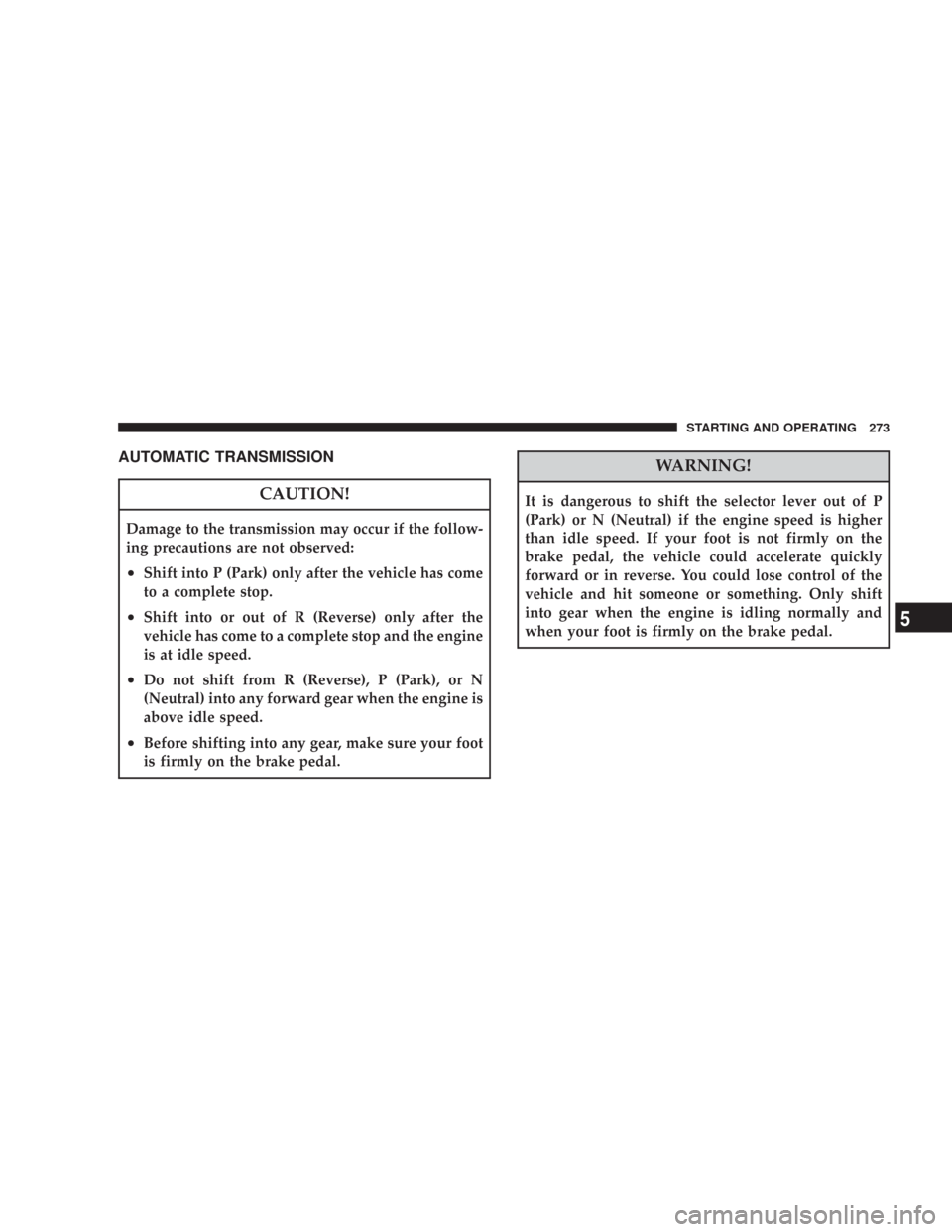
AUTOMATIC TRANSMISSION
CAUTION!
Damage to the transmission may occur if the follow-
ing precautions are not observed:
•Shift into P (Park) only after the vehicle has come
to a complete stop.
•Shift into or out of R (Reverse) only after the
vehicle has come to a complete stop and the engine
is at idle speed.
•Do not shift from R (Reverse), P (Park), or N
(Neutral) into any forward gear when the engine is
above idle speed.
•Before shifting into any gear, make sure your foot
is firmly on the brake pedal.
WARNING!
It is dangerous to shift the selector lever out of P
(Park) or N (Neutral) if the engine speed is higher
than idle speed. If your foot is not firmly on the
brake pedal, the vehicle could accelerate quickly
forward or in reverse. You could lose control of the
vehicle and hit someone or something. Only shift
into gear when the engine is idling normally and
when your foot is firmly on the brake pedal.
STARTING AND OPERATING 273
5
Page 274 of 467
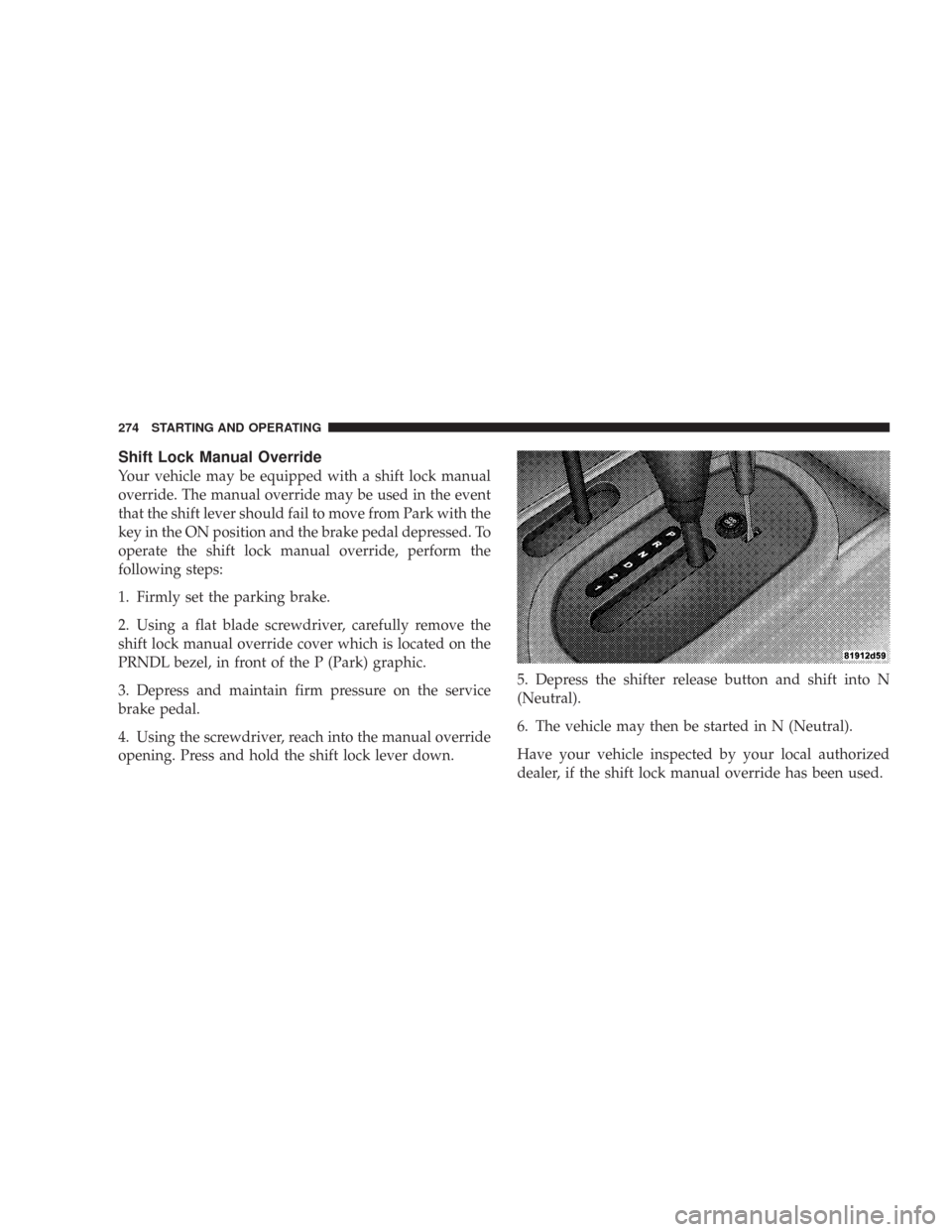
Shift Lock Manual Override
Your vehicle may be equipped with a shift lock manual
override. The manual override may be used in the event
that the shift lever should fail to move from Park with the
key in the ON position and the brake pedal depressed. To
operate the shift lock manual override, perform the
following steps:
1. Firmly set the parking brake.
2. Using a flat blade screwdriver, carefully remove the
shift lock manual override cover which is located on the
PRNDL bezel, in front of the P (Park) graphic.
3. Depress and maintain firm pressure on the service
brake pedal.
4. Using the screwdriver, reach into the manual override
opening. Press and hold the shift lock lever down.5. Depress the shifter release button and shift into N
(Neutral).
6. The vehicle may then be started in N (Neutral).
Have your vehicle inspected by your local authorized
dealer, if the shift lock manual override has been used.
274 STARTING AND OPERATING
Page 275 of 467
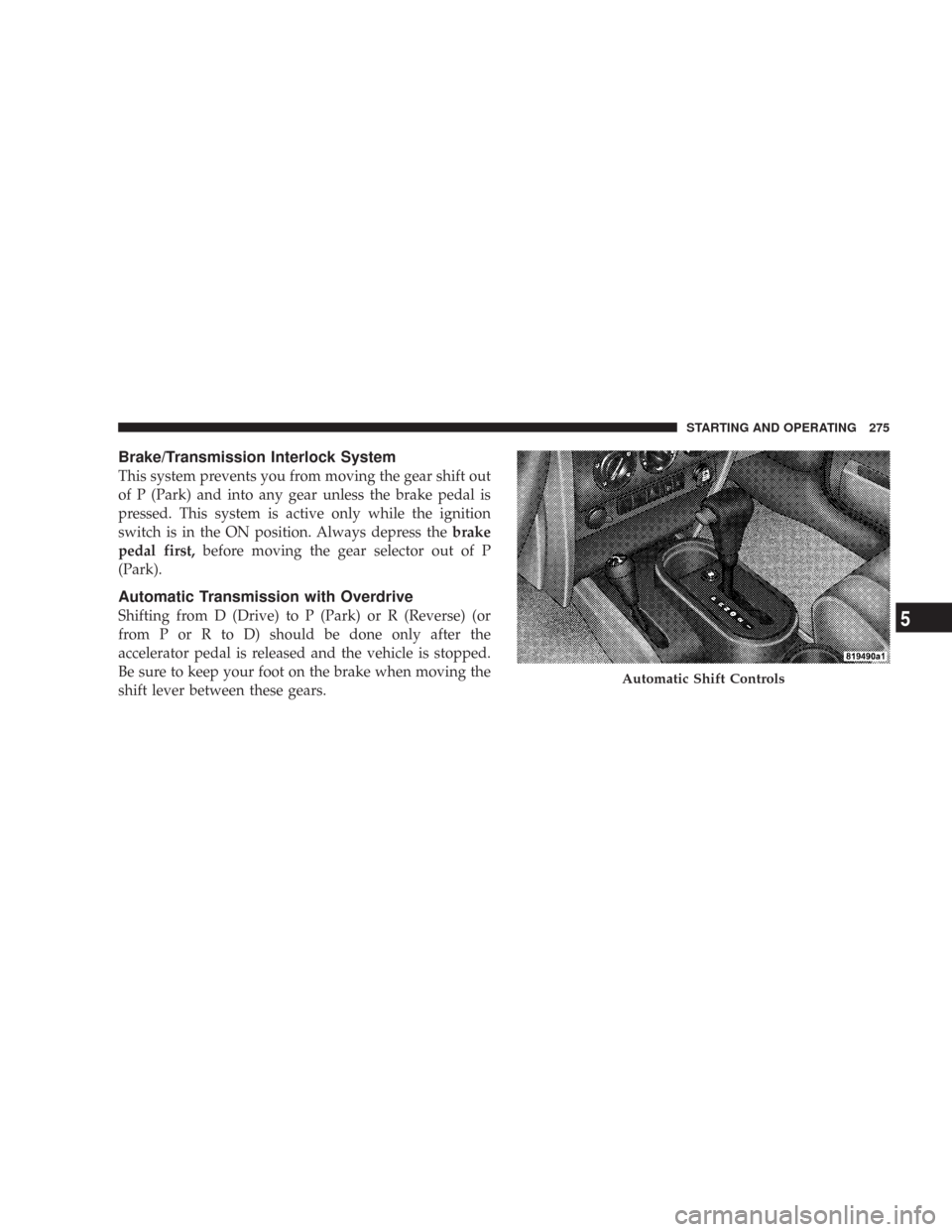
Brake/Transmission Interlock System
This system prevents you from moving the gear shift out
of P (Park) and into any gear unless the brake pedal is
pressed. This system is active only while the ignition
switch is in the ON position. Always depress thebrake
pedal first,before moving the gear selector out of P
(Park).
Automatic Transmission with Overdrive
Shifting from D (Drive) to P (Park) or R (Reverse) (or
from P or R to D) should be done only after the
accelerator pedal is released and the vehicle is stopped.
Be sure to keep your foot on the brake when moving the
shift lever between these gears.
Automatic Shift Controls
STARTING AND OPERATING 275
5
Page 276 of 467
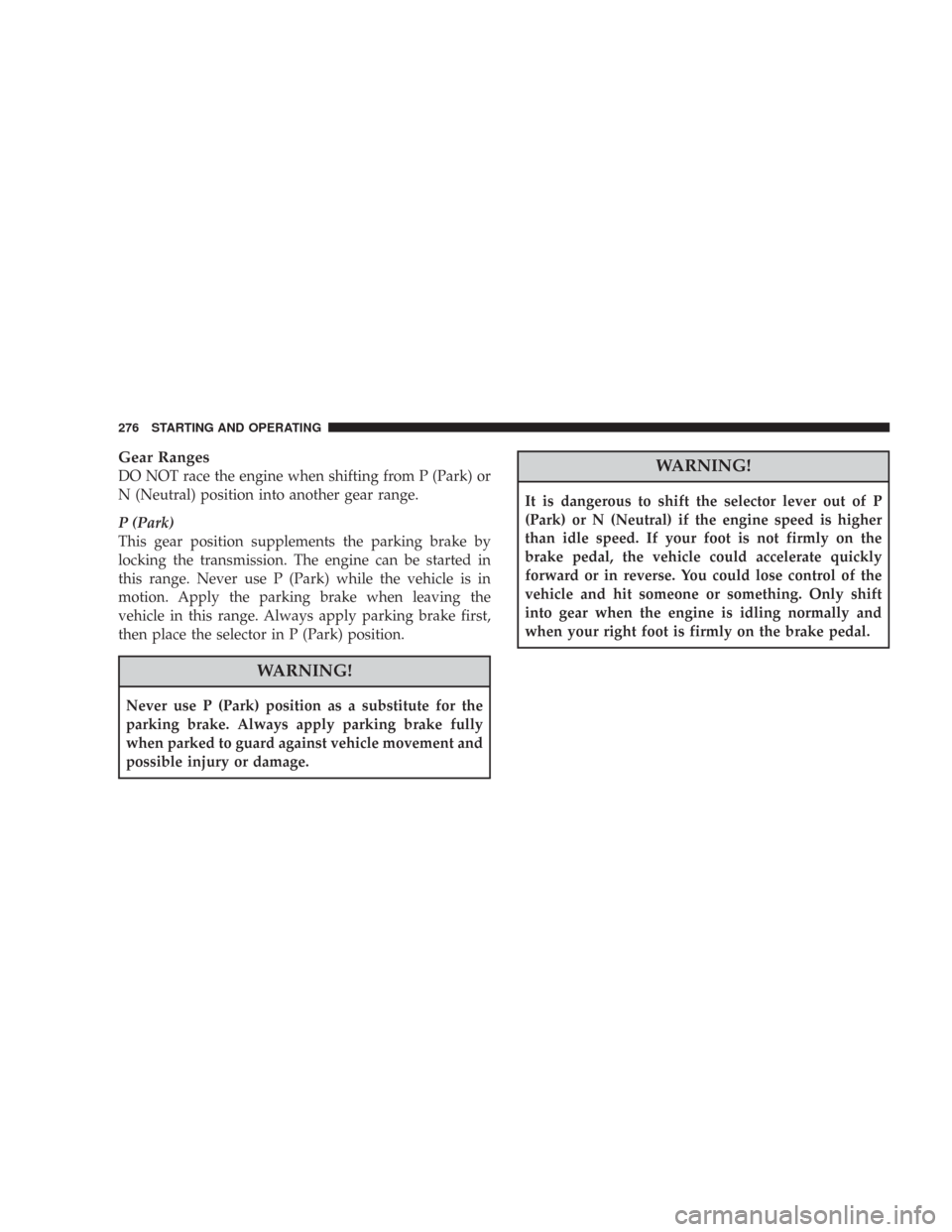
Gear Ranges
DO NOT race the engine when shifting from P (Park) or
N (Neutral) position into another gear range.
P (Park)
This gear position supplements the parking brake by
locking the transmission. The engine can be started in
this range. Never use P (Park) while the vehicle is in
motion. Apply the parking brake when leaving the
vehicle in this range. Always apply parking brake first,
then place the selector in P (Park) position.
WARNING!
Never use P (Park) position as a substitute for the
parking brake. Always apply parking brake fully
when parked to guard against vehicle movement and
possible injury or damage.
WARNING!
It is dangerous to shift the selector lever out of P
(Park) or N (Neutral) if the engine speed is higher
than idle speed. If your foot is not firmly on the
brake pedal, the vehicle could accelerate quickly
forward or in reverse. You could lose control of the
vehicle and hit someone or something. Only shift
into gear when the engine is idling normally and
when your right foot is firmly on the brake pedal.
276 STARTING AND OPERATING
Page 277 of 467

R (Reverse)
Use this range only after the vehicle has come to a
complete stop.
N (Neutral)
Shift into N (Neutral) when the vehicle is standing for
prolonged periods with the engine running. The engine
may be started in this range. Set the parking brake if you
must leave the vehicle.
NOTE:Towing the vehicle, coasting, or driving for any
other reason with selector lever in N (Neutral) can result
in severe transmission damage. Refer to “Recreational
Towing” in Section 5 and “Towing a Disabled Vehicle” in
Section 6 of this manual.Overdrive (O/D)
For most city and highway driving. The transmission
contains an electronically controlled Overdrive, and will
automatically shift from D (Drive) to O/D (Overdrive) if
the following conditions are present:
•The transmission selector is in D (Drive).
•The O/D OFF switch has not been activated.
•Vehicle speed is above approximately 30 mph (48
km/h).
STARTING AND OPERATING 277
5
Page 278 of 467
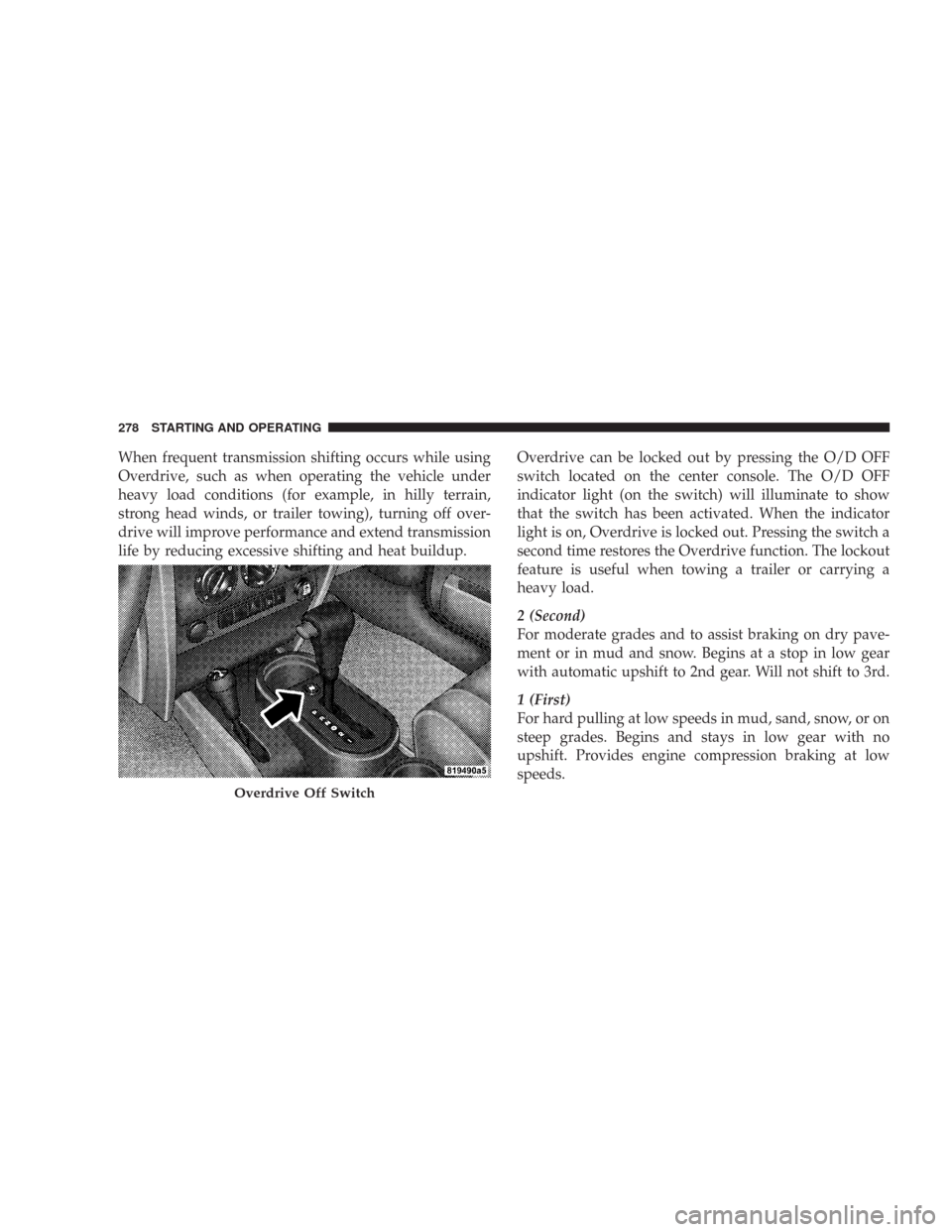
When frequent transmission shifting occurs while using
Overdrive, such as when operating the vehicle under
heavy load conditions (for example, in hilly terrain,
strong head winds, or trailer towing), turning off over-
drive will improve performance and extend transmission
life by reducing excessive shifting and heat buildup.Overdrive can be locked out by pressing the O/D OFF
switch located on the center console. The O/D OFF
indicator light (on the switch) will illuminate to show
that the switch has been activated. When the indicator
light is on, Overdrive is locked out. Pressing the switch a
second time restores the Overdrive function. The lockout
feature is useful when towing a trailer or carrying a
heavy load.
2 (Second)
For moderate grades and to assist braking on dry pave-
ment or in mud and snow. Begins at a stop in low gear
with automatic upshift to 2nd gear. Will not shift to 3rd.
1 (First)
For hard pulling at low speeds in mud, sand, snow, or on
steep grades. Begins and stays in low gear with no
upshift. Provides engine compression braking at low
speeds.
Overdrive Off Switch
278 STARTING AND OPERATING
Page 279 of 467
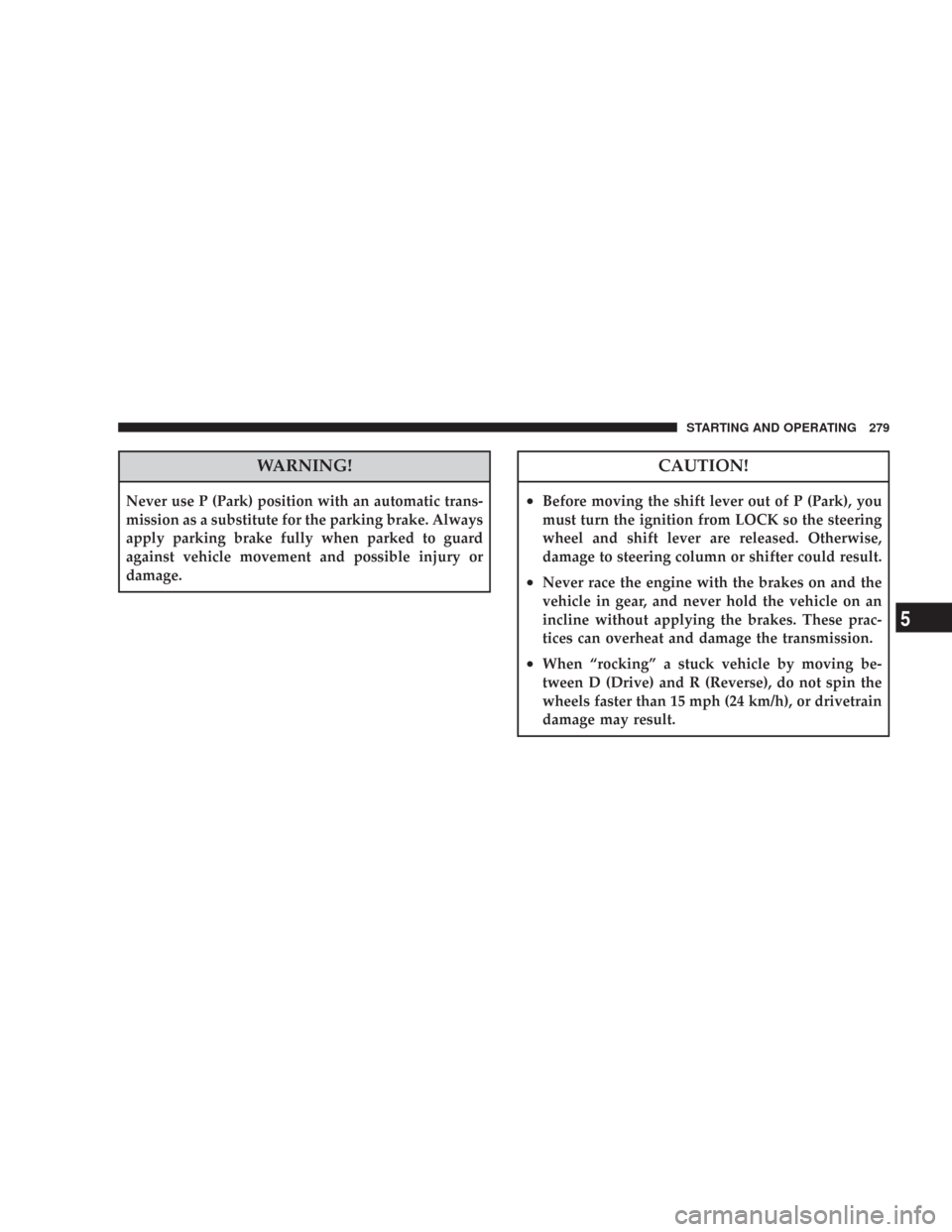
WARNING!
Never use P (Park) position with an automatic trans-
mission as a substitute for the parking brake. Always
apply parking brake fully when parked to guard
against vehicle movement and possible injury or
damage.
CAUTION!
•Before moving the shift lever out of P (Park), you
must turn the ignition from LOCK so the steering
wheel and shift lever are released. Otherwise,
damage to steering column or shifter could result.
•Never race the engine with the brakes on and the
vehicle in gear, and never hold the vehicle on an
incline without applying the brakes. These prac-
tices can overheat and damage the transmission.
•When “rocking” a stuck vehicle by moving be-
tween D (Drive) and R (Reverse), do not spin the
wheels faster than 15 mph (24 km/h), or drivetrain
damage may result.
STARTING AND OPERATING 279
5
Page 280 of 467
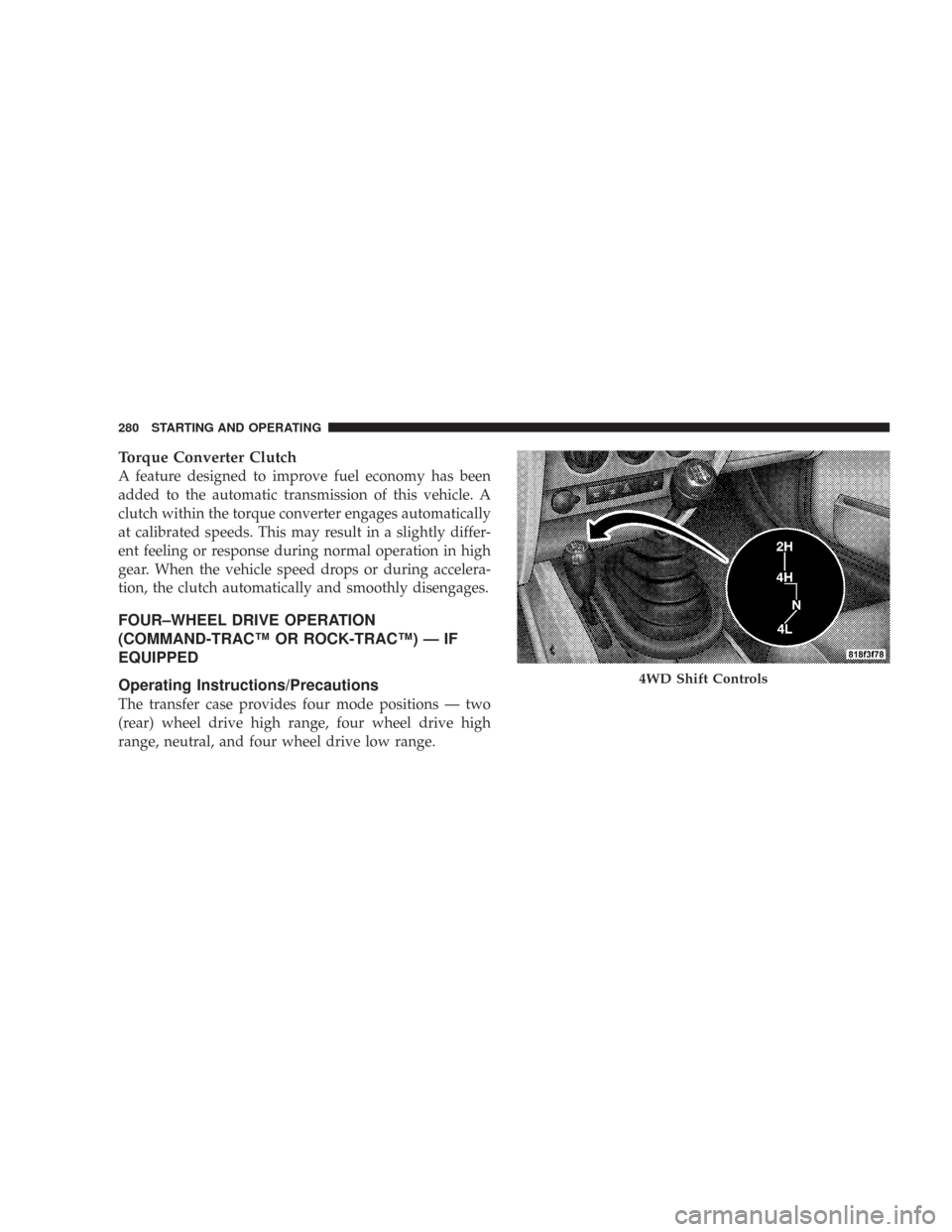
Torque Converter Clutch
A feature designed to improve fuel economy has been
added to the automatic transmission of this vehicle. A
clutch within the torque converter engages automatically
at calibrated speeds. This may result in a slightly differ-
ent feeling or response during normal operation in high
gear. When the vehicle speed drops or during accelera-
tion, the clutch automatically and smoothly disengages.
FOUR–WHEEL DRIVE OPERATION
(COMMAND-TRAC™ OR ROCK-TRAC™) — IF
EQUIPPED
Operating Instructions/Precautions
The transfer case provides four mode positions — two
(rear) wheel drive high range, four wheel drive high
range, neutral, and four wheel drive low range.
4WD Shift Controls
280 STARTING AND OPERATING